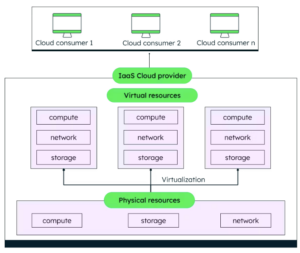Avoid overruns by adjusting your budgeting process for the digital reality
As companies aim to better understand and calculate the return on their cloud spend, they also confront the challenge of budgeting for growth in the cloud. Organizations estimate they waste 30% of their cloud budget, so it follows that any expansion of their cloud ambitions must be matched by a fundamental shift in budgeting processes.
Part of the solution lies in improving cost visibility and attribution to drive accountability to the relevant users and teams, as well as introducing tools to automate cost governance and streamline decision-making. However, these are just elements of a more fundamental issue: Organizations need to rethink their entire approach to cloud budgeting. In this article, we discuss ways in which companies can rethink their budgeting process to align their cloud spending with their growth ambitions.
Introduce organizational change
The public cloud enables the kind of flexibility that businesses need in order to adapt quickly to ever-changing market conditions, but companies need to adjust too. The IT, finance, product and management functions may be accustomed to working in isolation, but managing the trade-offs between cloud costs, quality and performance means they need to work more closely together. By introducing FinOps best practices such as collapsing silos and encouraging open communication and accountability between these functions, organizations can take the first step in managing their cloud budgets.
This means that engineers should be encouraged to manage cloud costs, viewing cost optimization as a further measure of cloud efficiency. Finance and business functions need to understand the speed and dynamism of IT. Both sides of the organization must be involved in agreeing the processes and practices for cloud use, striking a balance between reducing costs and investing in cloud resources that support business growth objectives.
This kind of close collaboration makes it easier to shake up the business planning and budgeting process, which traditionally takes place annually, with additional quarterly forecasts and financial planning. Cloud budgeting benefits from a more agile approach, with frequent feedback loops that give teams a chance to review and revise their resource allocations and cost models as required to accommodate market changes.
Business planning and budgeting may also be affected by changes in financial models to accommodate cloud use. The low initial investment and variable nature of billing mean cloud spend is usually treated as Opex (operational expenditure), whereas organizations are accustomed to counting investment in data centers as Capex (capital expenditure).
This shift makes it easier to forecast spend and align budgets with business expansion plans, but it requires careful management. Cloud providers offer different Opex payment options in terms of pricing and operations, based on variables including the type of cloud service, the service level and the duration of that service. Determining the best options to choose to make the right decisions for your business takes careful consideration.
Create visibility
Budgeting for growth in the cloud requires transparency, which can be difficult to attain as usage becomes more complex. The first step is to analyze the data on how the organization allocates, measures and budgets existing cloud resources and services.
Creating visibility into cloud spend highlights opportunities for meaningful cost-saving opportunities, including areas where you could leverage cloud compute discounts plans, right-size resources or use automated tools to turn off unused resources. With this kind of visibility in place, management can make informed decisions that drive prudent, realistic cloud budget-setting. Stakeholders see the business value of cloud, and decision-makers learn how to avoid unexpected costs and find opportunities to improve.
A properly managed tagging system for attributing spend is essential for illuminating your cloud consumption. With such a system in place, you can identify, track and manage resources effectively, making it easier to optimize spending and boost the ROI of cloud deployments. Tagging enables you to reconcile cost and usage data with the appropriate service and immediately identify any anomalies. Designed correctly your tagging system will attribute every item of cost and usage data to the appropriate team, making cloud budgets much easier to set accurately. It will also provide the metadata necessary for effective automation so users can be notified as soon as action is required.
Drive accountability
Now that you can see where your cloud spend is going, you can allocate responsibility for it to the appropriate team. Give each team the tools and resources they need to own their cloud use and align it with their available cloud budget. They should be empowered to create spending forecasts, track their spending and spot areas where they could optimize cloud costs.
This kind of accountability sets clear expectations for everyone and specifies the consequences of cloud budget overruns.
Cloud chargeback and showback are policies for associating the costs of cloud services with the business unit that uses them. They can be useful for instilling accountability and supporting future decision-making. With cloud chargebacks, departments are billed for the cloud resources they use, whereas showbacks simply notify each department of their usage without charging them. These and other measures encourage a decentralized approach to cloud budgeting that shifts responsibility to individual teams empowered with the visibility they need to balance their spending against their needs.
Enforce robust cost governance
With proper visibility and accountability in place, you have a strong foundation for proper cloud cost governance. Automating your cloud cost management as much as possible is the key to making it work. A robust automated cost governance system will alert you before you exceed your budget, inform you of cost spikes and underused resources, and identify savings opportunities that can be achieved through effective optimization.
By automating cloud cost management, you make policy creation and enforcement more efficient, freeing time and resources to focus on using the cloud to be more innovative and responsive to market needs. Products such as DoiT’s Flexsave help achieve this kind of efficiency, by maximizing your savings from reserved compute (Savings Plans, Reserved Instances, and/or Committed Use Discounts) with zero financial risk or management — automating cloud cost optimization to maximize savings with minimal input required from your organization.
Make cloud decisions based on business value
With companies averaging 23% overruns on their cloud budgets, the need to channel cloud spending more efficiently is clear. Business value should dictate decisions on whether to base workloads in the cloud or deploy them locally. Lift-and-shift migrations of legacy applications can actually increase costs because these applications were designed to run in a data center and will perform suboptimally, generating significant network traffic – and costs – when you run them in the cloud.
When you migrate a service to the cloud, you should optimize your architectural design to leverage the benefits of the cloud environment. This might mean using cloud-native products to perform service management and reducing the amount of unnecessary billable network traffic
Trending and variance analysis will help you see where your cloud spend is going. You can also benchmark cloud workloads and costs to evaluate how the business is performing. By continuously tracking and measuring cloud workload or resource utilization against costs, you get powerful insights into the value the cloud is generating for your business, allowing you to make adjustments to budgets accordingly.
Work with a partner
Changing the way your organization approaches cloud spend and introducing enhanced visibility, accountability, cost governance and business decision-making are certain to put you on a surer footing when it comes to budgeting for growth in the cloud. But these are not simple measures for any organization to implement.
Few companies have the internal resources to design and implement a system of budgeting for the public cloud that will set them on the path of sustained growth. However, by engaging with a partner who specializes in helping companies accelerate growth and optimize for ongoing success through the cloud, you can get on with your business, confident that your cloud budgeting decisions will help you thrive.


